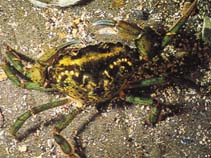Carcinus maenas (Linnaeus, 1758)
Green crab| Native range | All suitable habitat | Point map | Year 2050 |

|
| This map was computer-generated and has not yet been reviewed. |
| Carcinus maenas AquaMaps Data sources: GBIF OBIS |
Классификация / Names народные названия | синонимы | CoL | ITIS | WoRMS
Malacostraca | Decapoda | Carcinidae
Environment: milieu / climate zone / пределы глубины / distribution range экология
; солоноватоводный; пределы глубины 0 - 200 m (ссылка 2779), usually 0 - 6 m (ссылка 114208). Subtropical; -1°C - 22°C (ссылка 114208), preferred 12°C (ссылка 107945); 70°N - 22°N, 20°W - 19°E (ссылка 114232)
Distribution страны | регионы FAO | Ecosystems | места находок | интродукции
Eastern Atlantic: From Great Britain north to Iceland, the North Sea and Norway, south to Portugal and Spain to Mauritania. Introduced and established in North America, South Africa (Cape Town), and Australia. Introduced but not established in Panama, Brazil, Pakistan, Sri Lanka, Madagascar, Myanmar, Japan and Hawaii. Subtropical to polar.
Length at first maturity / Size / Weight / Возраст
половая зрелость: Lm ?, range 1 - 4.5 cm Max length : 6.0 cm CL самец/пол неопределен; (ссылка 435); common length : 4.0 cm CL самец/пол неопределен; (ссылка 435); наибольший возраст (опубликованны данные): 7 годы (ссылка 128193)
Life cycle and mating behavior половая зрелость | размножение | нерест | Eggs | Fecundity | Larvae
Основная ссылка
ссылки | координатор | соавторы
Fischer, W., G. Bianchi and W.B. Scott (eds.) 1981 True Crabs. 6: pag.var. In FAO species identification sheets for fishery purposes. Eastern Central Atlantic (fishing areas 34, 47; in part). Canada Funds-in-Trust. Ottawa, Department of Fisheries and Oceans Canada, by arrangement with the Food and AgriculturesOrganization of the United Nations, 1-7: pag.var. (ссылка 435)
Статус Красного Списка МСОП
(ссылка 130435: Version 2025-1)
Статус СИТЕС (ссылка 108899)
CMS (ссылка 116361)
Угроза для людей
Использование человеком
рыболовство: коммерческий
FAO - рыболовство: landings | FishSource | Sea Around Us
инструменты
дополнительная информация
ресурсы в Интернет
BHL | BOLD Systems | CISTI | DiscoverLife | FAO(рыболовство: ; publication : search) | Fishipedia | GenBank (Геном, Нуклеотид) | GloBI | Gomexsi | Google Books | Google Scholar | Google | PubMed | Tree of Life | Wikipedia (Вперёд, поиск) | Zoological Record



